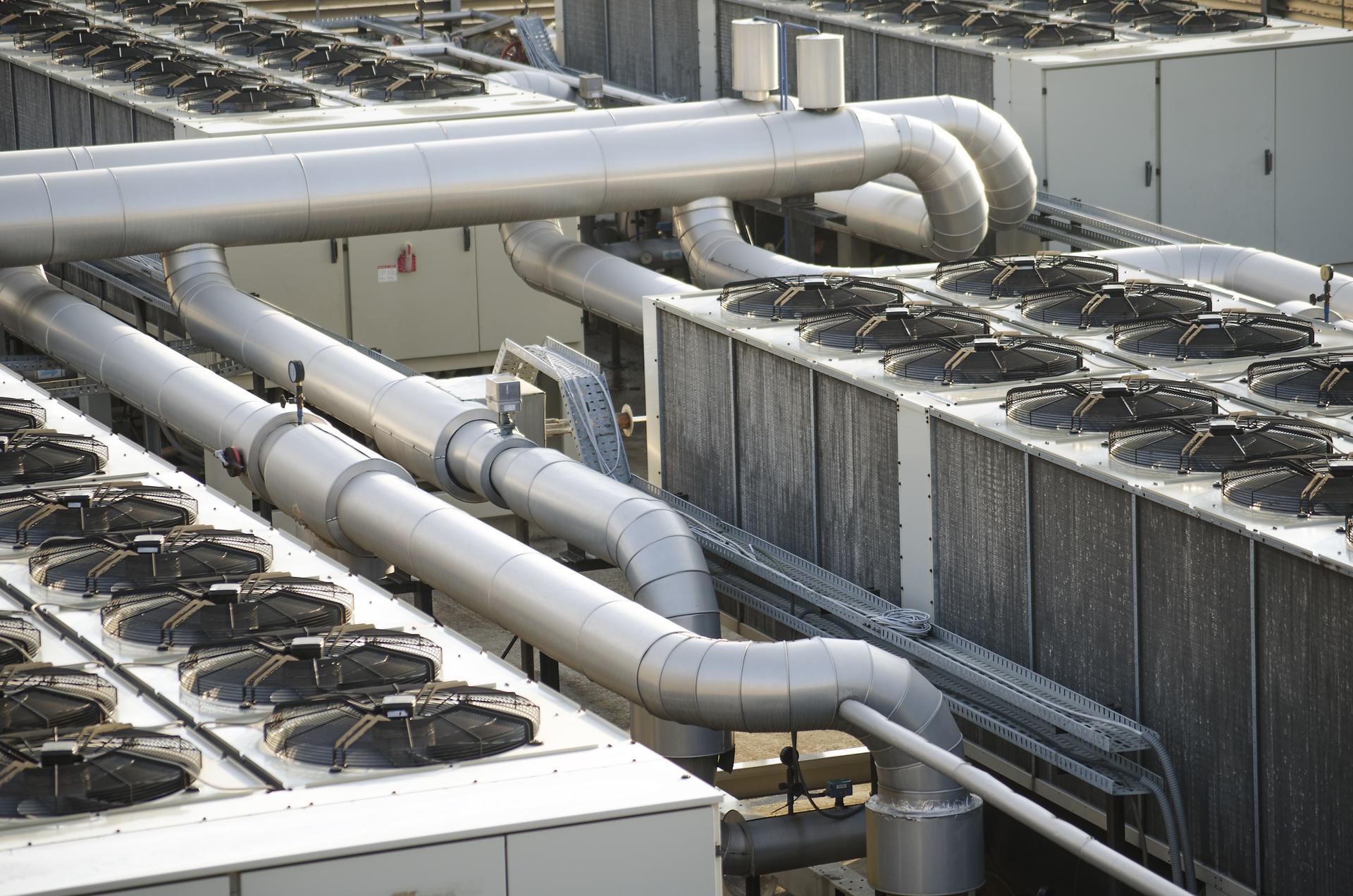ABSORPTION REFRIGERATION -
COOLING FROM HEAT
The diversity of the range of products available today correlates with the varied and complex production conditions required for these products. Some processes may require steam, hot water as well as cooling in addition to electricity. With combined cooling, heat and power plants (CCHP), these forms of energy can be generated together allowing them to be delivered efficiently.
Even companies that do not have a significant heating demand can take advantage of combined heat and power (CHP) if absorption refrigeration units are used to generate cooling from the surplus heat. Absorption refrigeration technology offers an ideal way to recover engine heat from a CHP unit and thus to supply the production process with cooling, electricity and, if necessary, steam and hot water.
Together we will find the energy solution that is right for you.

PRACTICAL USE OF
CHP MOTOR HEAT
Many industrial companies depend on low energy prices in order to remain competitive. Gradual increase in government-mandated price components including the EEG levy on electricity prices presents a clear danger to this competitiveness. Only a small number of companies are exempted from the EEG levy, which means that the majority is affected.
One solution for companies that are affected is to generate their own electricity and thus benefit from a reduction of charges. Despite larger investments and ongoing costs for things such as maintenance and repair, it is still possible to sustainably reduce electricity costs. Due to the significantly lower capital expenditures, motor-driven CHP units are often used in this context. In addition to electricity generation, hot waste gases can be used for steam generation and can also be fed into the plant grid. Plants that generate electricity and heat at the same time are called combined heat and power plants and are known for their high fuel efficiency and environmental friendliness. Such plants are also state subsidized because of their particular attributes and efficiency, and because they help to lower energy costs.
In a CHP unit, hot water with temperatures of around 90°C is produced the cooling of the motor. In order to ensure sufficient cooling of the motor, the cooling water temperature must be lowered to around 70°C. Experience has shown that most production companies have an electricity and steam requirement that can be at least partially covered with the help of a CHP unit. But a lot of companies need little to no hot water. To operate a CHP unit in an efficient, economical and environmentally-friendly manner, it is necessary to make use of the excess heat. Absorption refrigeration units are ideally suited to this purpose. It is only through the use of absorption refrigeration units that it may be possible to operate a combined heat and power unit, or a CHP unit with a higher capacity can be selected, thereby meeting a larger part of the energy demand.
Compression refrigeration machines are usually used to generate cooling. These use an electric-powered compressor to raise the gaseous refrigerant from a low to a high pressure level.
Instead of an electric compressor, absorption refrigeration units use a so-called thermal compressor which uses heat instead of electricity. The thermal compressor works with the help of a mixture of substances that includes a coolant and a solvent One property of the solvent is that it is able to absorb the coolant. The solvent is therefore also referred to as a sorbent.
At the beginning of the thermal compression, a mixture of solvent and coolant is present in liquid form, also referred to as a rich solution because a relatively large amount of coolant is dissolved in it. The liquid can be brought to a higher pressure level with a very low expenditure of pump energy. For this reason, absorption refrigeration units usually cannot do completely without electrical energy.
COOLANTS AND SOLVENTS
Because they boil at different temperatures, it is possible to separate the coolant from the solvent through heating. This process is carried out in the generator, otherwise known as the expulsion unit, by introducing external heat, for example the excess heat from the CHP unit. The boiled coolant steam is routed to the condenser (liquefier). There, liquefaction of the coolant takes place, releasing heat to the environment. With the help of a throttle, the coolant is expanded to the lower pressure level and routed to the evaporator. Due to the low steam pressure, the heat of the cooling circuit return is sufficient to evaporate the coolant. This removes heat from the cooling circuit so that it can provide cooling. Next, the gaseous coolant is brought into contact in the absorber with the expanded and now low coolant solution from the generator. In the process, the coolant is bound in the solution and can be pumped to the generator again.
The difference in concentration between coolant-rich and low-coolant solution is called the degassing range and is considered a measure of the effectiveness of the thermal compressor. The objective should be to achieve the widest possible degassing range. The temperature of the re-cooling is determined by the ambient temperature while the temperature at which the cooling capacity is to be provided depends on the process conditions. This means that the temperature of the heat source used to expel the coolant in the generator needs to be raised in order to increase the degassing range. The greater the degassing range, the greater the extent to which the heating medium can be cooled. This in turn enables greater transfer capacities.
If you take only the capacities into account, you can use the thermal ratio. The thermal ratio describes the cooling capacity achieved in relation to the heat capacity used at the temperatures applicable to the system.
Internal heat exchangers are still used to improve processes within the absorption refrigeration unit, thus increasing the efficiency of the plant.
COOLANT SYSTEMS
Two systems have established themselves on the market, each of which operates with different working substance pairs: water-lithium bromide and ammonia-water. The former is used when cooling temperatures above 0°C are required. If deep-freezing is needed, using ammonia as a coolant must be avoided as a coolant. Systems such as these are much more complex and require rectification equipment to generate high concentrations of cooling vapor.
AIR CONDITIONINg
Absorption refrigeration units for air-conditioning on the basis of lithium bromide are now readily available on the market as compact units with various capacity ranges. In combination with the low-temperature heat from a CHP unit, process or air conditioning can be efficiently provided for the cooling of office buildings or cold storage facilities.
DEEP FREEZING
Use of the low-temperature waste heat from a CHP unit for low-temperature refrigeration in an absorption refrigeration unit is limited by the heating temperature of approximately 90°C. For one thing, single-stage units can only produce cooling in the single-digit minus range and, in addition, the thermal ratio of this type of unit is rather low. Not only that, but under certain circumstances, refrigeration of the heating medium will not be sufficient to ensure the cooling of the CHP motor circuit within safe limits, making engineering solutions necessary for the utilization of the residual thermal volume. It might also be possible to achieve lower temperatures and ensure sufficient cooling of the CHP unit by using multi-stage systems. Systems such as these are currently only used in special cases or for research purposes due to the extensive equipment required.
Nevertheless, the combination of CHP, waste heat boiler and absorption refrigeration unit provides a financial as well as an ecological advantage compared to the reference case with external electricity supply, compression refrigeration and complete steam generation from a natural gas boiler.
Due to the considerable investment costs in the refrigeration unit and treatment stages, the economic advantage does not so much result from the fact that the absorption refrigeration unit replaces refrigeration from a compression refrigeration unit, but rather from the fact that expensive external electricity can be replaced through the generation of the unit's own electricity and steam can be provided extremely cost-effectively in a waste heat boiler.
The ecological advantage of such a system arises from the efficient use of fuel and the fact that the primary energy factor for natural gas is significantly lower than the primary energy factor for electricity. The fact that the amount of electricity purchased from outside sources can be reduced also reduces the amount of primary energy required to supply the plant with energy.
For a CHP unit with an electrical output of 2 MW, which continues to contribute to the supply of saturated steam at 10 bar(g) using a waste heat boiler and provides cryogenic cooling of about -7°C from an absorption refrigeration unit, a primary energy saving of more than 15% is possible! If the saturated steam is required at a lower pressure or the refrigeration at a higher temperature level, the efficiency of the CCHP plant improves, resulting in even greater primary energy savings.
ABSORPTION REFRIGERATION
Generation of cooling using an absorption refrigeration unit is climate-friendly due to
- the use of waste heat
- low electricity consumption
Generation of cooling in system combination with a CHP (and waste heat boiler) is more cost-effective than a separate energy supply because:
- Economic advantages from Combined Heat and Power Act and EEG
- Energy/electricity tax exemption
- Possibility of subsidies for absorption refrigeration units and cooling grids
Trova il tuo contatto.
CON PIU’ DI 70 SEDI IN TUTTA L’EUROPA, SIAMO VICINI AI NOSTRI CLIENTI

